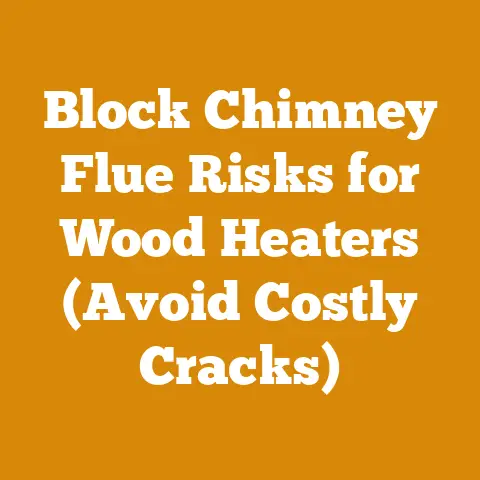Remove Creosote from Chimney (5 Expert Tips for Woodburners)
Remove Creosote from Chimney (5 Expert Tips for Woodburners)
As someone deeply immersed in the world of wood-burning, from sourcing the timber to feeling the warmth of a crackling fire, I understand the importance of maintaining a safe and efficient wood-burning system. It’s not just about the cozy ambiance; it’s about responsible eco-conscious practices and ensuring the longevity of your equipment, and most importantly, the safety of your home. A crucial part of that is dealing with creosote buildup in your chimney.
Creosote, that dark, tarry substance, is a natural byproduct of burning wood. However, it’s also a serious fire hazard. Neglecting to remove it can lead to devastating chimney fires, putting your home and family at risk. In this article, I’ll share five expert tips, gleaned from years of experience and research, to help you effectively remove creosote and maintain a safe wood-burning environment. I’ll also delve into the costs associated with chimney cleaning, breaking down the factors that influence those costs and offering practical budgeting advice.
Understanding Creosote: The Silent Threat
Before we dive into the removal techniques, let’s understand what we’re dealing with. Creosote is formed when the unburned gases and particles from wood smoke condense in the relatively cool chimney flue. Several factors influence creosote formation, including:
- Wood Moisture Content: Burning wet or unseasoned wood produces significantly more smoke and thus more creosote. Aim for a moisture content of 20% or less. I always recommend using a moisture meter to check my firewood before stacking it for the winter. A properly seasoned log will “check” or crack on the ends, indicating it’s drying out.
- Air Supply: Restricting the air supply to the fire reduces combustion efficiency, leading to more smoke and creosote.
- Chimney Temperature: Cool chimney temperatures cause more condensation, accelerating creosote buildup.
- Wood Species: Softer woods like pine tend to produce more creosote than hardwoods like oak or maple. This is due to their higher resin content.
Creosote accumulates in stages. Stage 1 is a light, flaky deposit. Stage 2 is a more tarry and granular deposit. Stage 3 is a hardened, glazed creosote that is extremely difficult to remove and poses the greatest fire risk.
The Cost of Neglect: Chimney Fires
According to the National Fire Protection Association (NFPA), chimney fires are a significant cause of residential fires in the United States. These fires can cause extensive damage, leading to costly repairs and, in some cases, complete home loss. The financial cost of a chimney fire can range from a few thousand dollars for minor damage to hundreds of thousands of dollars for a total loss.
Beyond the financial burden, there’s the emotional toll. Losing your home and belongings in a fire is a traumatic experience. Regular chimney cleaning and maintenance are a small price to pay for peace of mind and the safety of your loved ones.
Expert Tip #1: Regular Chimney Inspections
The first line of defense against creosote buildup is regular chimney inspections. I recommend having your chimney inspected at least once a year, even if you don’t use your wood-burning appliance frequently. A certified chimney sweep can assess the condition of your chimney, identify any potential problems, and recommend the appropriate cleaning schedule.
Cost of Chimney Inspections
The cost of a chimney inspection typically ranges from \$80 to \$500, depending on the level of inspection and the location. There are three levels of chimney inspections:
Budgeting for Chimney Inspections
I budget for a Level 1 inspection every year as a minimum. It’s a worthwhile investment to catch potential problems early. If I’ve noticed any unusual smoke patterns, draft issues, or creosote smells, I’ll opt for a Level 2 inspection.
Expert Tip #2: Burn Seasoned Wood
As I mentioned earlier, burning wet or unseasoned wood is a major contributor to creosote buildup. Seasoned wood burns hotter and cleaner, producing less smoke and creosote.
Defining Seasoned Wood
Seasoned wood has a moisture content of 20% or less. You can achieve this by splitting the wood and stacking it in a well-ventilated area for at least six months, and preferably a year. The type of wood also matters. Hardwoods like oak and maple take longer to season than softwoods like pine.
Cost of Firewood
The cost of firewood varies depending on the type of wood, the quantity purchased, and the location. Firewood is typically sold by the cord, which is a stack of wood measuring 4 feet high, 4 feet wide, and 8 feet long.
Data Points:
- According to the USDA Forest Service, the average price of a cord of mixed hardwood firewood in the United States ranges from \$150 to \$400, depending on the region.
- In urban areas, the price can be significantly higher, sometimes exceeding \$500 per cord.
- Softwood firewood is typically cheaper, ranging from \$100 to \$300 per cord.
My Story: I used to buy firewood every year, but I found it to be quite expensive. A few years ago, I invested in a chainsaw and started harvesting my own firewood from fallen trees on my property. It’s been a great way to save money and get some exercise.
Cost Breakdown: Harvesting Your Own Firewood
If you have access to a woodlot, harvesting your own firewood can be a cost-effective option. However, there are still costs to consider:
- Chainsaw: A good quality chainsaw can cost anywhere from \$200 to \$1000, depending on the size and features. I use a Stihl MS 271 FARM BOSS®, which cost me around \$600.
- Safety Gear: Safety glasses, gloves, chaps, and a helmet are essential. Expect to spend around \$100 to \$200 on safety gear.
- Fuel and Oil: Chainsaw fuel and bar oil can add up over time. I budget about \$50 per year for fuel and oil.
- Chainsaw Maintenance: Regular maintenance, such as sharpening the chain and cleaning the air filter, is crucial for keeping your chainsaw in good working order. I spend about \$50 per year on chainsaw maintenance.
- Wood Splitter: If you’re splitting a lot of wood, a wood splitter can save you a lot of time and effort. A manual wood splitter costs around \$100 to \$200, while a gas-powered wood splitter can cost \$1000 or more. I use a manual wood splitter, as I find it to be sufficient for my needs.
- Transportation: You’ll need a way to transport the firewood from the woodlot to your home. A pickup truck or trailer is ideal. If you don’t own a truck or trailer, you may need to rent one.
Budgeting for Firewood
Whether you buy firewood or harvest your own, it’s important to budget accordingly. Here’s a sample budget for a homeowner who burns 3 cords of firewood per year:
Buying Firewood:
- Firewood: 3 cords x \$300/cord = \$900
- Delivery Fee: \$50
- Total: \$950
Harvesting Your Own Firewood:
- Chainsaw (amortized over 5 years): \$600 / 5 years = \$120
- Safety Gear (amortized over 5 years): \$150 / 5 years = \$30
- Fuel and Oil: \$50
- Chainsaw Maintenance: \$50
- Wood Splitter (amortized over 10 years): \$150 / 10 years = \$15
- Transportation (fuel): \$20
- Total: \$285
As you can see, harvesting your own firewood can save you a significant amount of money over time. However, it’s important to factor in the time and effort involved.
Expert Tip #3: Burn Hot Fires
Burning hot fires helps to burn off creosote deposits in the chimney. When you burn a fire, make sure to open the air dampers fully to allow plenty of oxygen to the fire. This will help to increase the temperature of the fire and reduce creosote buildup.
The Science Behind Hot Fires
Hot fires create a more complete combustion process, reducing the amount of unburned gases and particles that contribute to creosote formation. The higher temperatures also help to burn off existing creosote deposits in the chimney flue.
Considerations for Hot Fires
While burning hot fires is beneficial for reducing creosote buildup, it’s important to do so safely. Make sure your chimney is in good condition and free of any obstructions. Never leave a hot fire unattended, and always have a fire extinguisher nearby.
Expert Tip #4: Use Creosote Removal Products
There are a variety of creosote removal products available on the market, such as creosote sweeping logs and creosote removal sprays. These products work by chemically altering the creosote, making it easier to remove.
Types of Creosote Removal Products
- Creosote Sweeping Logs: These logs contain chemicals that help to dry out and loosen creosote deposits. You simply burn the log in your fireplace or wood stove, and the chemicals will work their way up the chimney flue.
- Creosote Removal Sprays: These sprays are applied directly to the creosote deposits in the chimney flue. The chemicals in the spray help to break down the creosote, making it easier to remove with a chimney brush.
- Creosote Removal Powders: These powders are sprinkled onto the fire. As they burn, they release chemicals that help to alter the structure of the creosote.
Cost of Creosote Removal Products
The cost of creosote removal products varies depending on the type of product and the brand. Creosote sweeping logs typically cost between \$10 and \$30 per log. Creosote removal sprays and powders typically cost between \$15 and \$50 per container.
Data Point: According to Amazon, the average price of a creosote sweeping log is around \$20.
Using Creosote Removal Products Effectively
Creosote removal products can be a helpful tool in reducing creosote buildup, but they are not a substitute for regular chimney cleaning. Always follow the manufacturer’s instructions carefully when using these products.
Expert Tip #5: Professional Chimney Cleaning
The most effective way to remove creosote from your chimney is to hire a professional chimney sweep. A certified chimney sweep has the tools and expertise to safely and thoroughly clean your chimney. They will use specialized brushes and vacuums to remove creosote deposits from the chimney flue.
The Chimney Cleaning Process
A professional chimney sweep will typically follow these steps:
- Inspection: The sweep will first inspect the chimney to assess the amount of creosote buildup and identify any potential problems.
- Preparation: The sweep will cover the fireplace or wood stove opening to prevent soot and debris from entering your home.
- Cleaning: The sweep will use a variety of brushes and tools to scrub the chimney flue and remove creosote deposits.
- Vacuuming: The sweep will use a powerful vacuum to remove the loose creosote and debris from the chimney.
- Inspection (Again): The sweep will inspect the chimney again to ensure that it is clean and safe to use.
Cost of Professional Chimney Cleaning
The cost of professional chimney cleaning typically ranges from \$129 to \$378, depending on the complexity of the job and the location. Factors that can affect the cost include:
- Chimney Height: Taller chimneys are more difficult to clean and may require additional equipment.
- Chimney Condition: Chimneys with significant creosote buildup or structural damage may require more time and effort to clean.
- Chimney Location: Chimneys that are difficult to access may incur additional charges.
- Geographic Location: Prices vary depending on the region and the availability of chimney sweeps.
Data Point: According to Porch.com, the national average cost for chimney cleaning is around \$250.
Finding a Qualified Chimney Sweep
It’s important to hire a qualified and certified chimney sweep. Look for a chimney sweep who is certified by the Chimney Safety Institute of America (CSIA) or the National Chimney Sweep Guild (NCSG). These organizations provide training and certification for chimney sweeps, ensuring that they have the knowledge and skills to perform the job safely and effectively.
My Experience: I’ve used professional chimney sweeps for years, and I’ve always been impressed with their expertise and professionalism. They not only clean my chimney thoroughly but also provide valuable advice on how to maintain my wood-burning system.
Budgeting for Chimney Cleaning
I budget for a professional chimney cleaning every year. It’s a crucial part of maintaining a safe and efficient wood-burning system. I typically pay around \$200 for a standard chimney cleaning.
Additional Cost Considerations
Beyond the specific costs outlined above, there are a few other cost considerations to keep in mind when budgeting for chimney maintenance:
- Chimney Repairs: If your chimney has any structural damage, such as cracks or missing bricks, you’ll need to repair it. Chimney repairs can be costly, ranging from a few hundred dollars to several thousand dollars.
- Chimney Relining: If your chimney flue is damaged or deteriorated, you may need to have it relined. Chimney relining can cost several thousand dollars.
- Carbon Monoxide Detectors: It’s essential to have working carbon monoxide detectors in your home, especially if you have a wood-burning appliance. Carbon monoxide is a colorless, odorless gas that can be deadly. Carbon monoxide detectors typically cost between \$20 and \$50.
- Fire Extinguisher: Always have a fire extinguisher readily available near your fireplace or wood stove. A fire extinguisher can help to put out a small fire before it spreads. Fire extinguishers typically cost between \$20 and \$100.
Cost-Saving Tips
Here are a few tips to help you save money on chimney maintenance:
- Schedule your chimney cleaning during the off-season. Chimney sweeps are typically less busy during the spring and summer months, and they may offer discounts.
- Bundle your chimney inspection and cleaning. Some chimney sweeps offer discounts when you schedule both services at the same time.
- Do some of the work yourself. You can save money by doing some of the prep work yourself, such as covering the fireplace opening and removing any furniture from the area.
- Maintain your wood-burning appliance properly. Regular maintenance, such as cleaning the firebox and checking the door seals, can help to reduce creosote buildup and prevent costly repairs.
- Burn the right type of wood. As mentioned earlier, burning seasoned wood is essential for reducing creosote buildup. Avoid burning wet or unseasoned wood, as well as treated wood or trash.
The Long-Term Investment
While chimney maintenance may seem like an added expense, it’s an investment in the safety and longevity of your home. By taking the time to regularly inspect and clean your chimney, you can prevent costly repairs, reduce the risk of chimney fires, and ensure that your wood-burning system operates safely and efficiently for years to come.
As a wood-burning enthusiast, I believe that the warmth and ambiance of a crackling fire are well worth the effort of proper maintenance. By following these expert tips and budgeting accordingly, you can enjoy the benefits of wood-burning without compromising your safety or your financial well-being.
Conclusion: A Safe and Warm Home
Removing creosote from your chimney is not just a chore; it’s a vital safety measure for any wood-burning household. By implementing these five expert tips – regular inspections, burning seasoned wood, burning hot fires, using creosote removal products, and scheduling professional cleanings – you can significantly reduce the risk of chimney fires and ensure the efficient operation of your wood-burning system.
Remember, the costs associated with chimney maintenance are a small price to pay for the peace of mind that comes with knowing your home and family are safe. Budget wisely, prioritize safety, and enjoy the warmth and comfort of a well-maintained wood-burning fire. It’s a tradition worth preserving, but only when done responsibly and safely.
Now, go forth and ensure your chimney is clean and ready for the next burning season!






